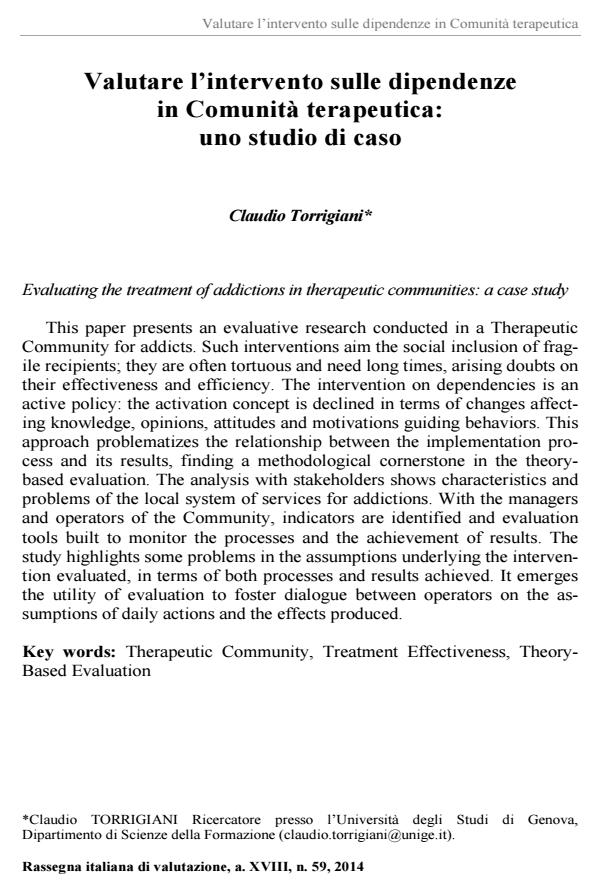Evaluating the treatment of addictions in therapeutic communities: a case study
Journal title RIV Rassegna Italiana di Valutazione
Author/s Claudio Torrigiani
Publishing Year 2015 Issue 2014/59 Language Italian
Pages 18 P. 148-165 File size 119 KB
DOI 10.3280/RIV2014-059008
DOI is like a bar code for intellectual property: to have more infomation
click here
Below, you can see the article first page
If you want to buy this article in PDF format, you can do it, following the instructions to buy download credits

FrancoAngeli is member of Publishers International Linking Association, Inc (PILA), a not-for-profit association which run the CrossRef service enabling links to and from online scholarly content.
This paper presents an evaluative research conducted in a Therapeutic Community for addicts. Such interventions aim the social inclusion of fragile recipients; they are often tortuous and need long times, arising doubts on their effectiveness and efficiency. The intervention on dependencies is an active policy: the activation concept is declined in terms of changes affecting knowledge, opinions, attitudes and motivations guiding behaviors. This approach problematizes the relationship between the implementation process and its results, finding a methodological cornerstone in the theorybased evaluation. The analysis with stakeholders shows characteristics and problems of the local system of services for addictions. With the managers and operators of the Community, indicators are identified and evaluation tools built to monitor the processes and the achievement of results. The study highlights some problems in the assumptions underlying the intervention evaluated, in terms of both processes and results achieved. It emerges the utility of evaluation to foster dialogue between operators on the assumptions of daily actions and the effects produced.
Keywords: Therapeutic Community, Treatment Effectiveness, Theory- Based Evaluation
- Bertin G. (2009), Complessità e valutazione: l’impatto sulle pratiche dei servizi sociosanitari, Rassegna Italiana di Valutazione, a. XIII, n. 45, pp. 47-72.
- Bezzi C. e Morandi G. (2007), Si può valutare il trattamento delle dipendenze? Un approccio pragmatico a contesti controversi, Rassegna Italiana di Valutazione, a. XI, n. 37, pp. 23-46.
- Callaghan G. (2008), Evaluation and Negotiated Order, Evaluation, vol. 14, n. 4, pp. 399-412. De Ambrogio, U. (a cura di) (2003), Valutare gli interventi e le politiche sociali, Carocci, Roma.
- Donaldson S.I., (2007), Program Theory-Driven Evaluation Science. Strategies and Applications, Psychology Press, Taylor & Francis Group, New York.
- American Psychiatric Association (2014), DSM-5 Manuale diagnostico e statistico dei disturbi mentali, RaffaelloCortina Editore, Milano.
- Marsden J., Ogborne A. Farrell M. e Rush B. (a cura di) (2000), International guidelines for the evaluation of treatment services and systems for psychoactive substance use disorders, WHO/UNDCP/EMCDDA.
- McLellan A.T., Luborsky L., Woody G.E. e O'Brien C.P. (1980), An improved diagnostic instrument for substance abuse patients: The Addiction Severity Index, Journal of Nervous and Mental Disease, vol. 168: 26-33.
- Nestler, E. J. (2004). Historical review: molecular and cellular mechanisms of opiate and cocaine addiction. Trends in Pharmacological Sciences, 25(4): 210-218.
- OMS, OEDT e UNDCP, (2006), “Linee guida internazionali per la valutazione dei servizi e dei sistemi per il trattamento dei disturbi da uso di sostanze psicoattive”. In G. Serpelloni, T. Macchia e F. Mariani (a cura di), OUTCOME La valutazione dei risultati e l'analisi dei costi nella pratica clinica nelle tossicodipendenze, Ministero Solidarietà Sociale, pp. 21-52.
- Palumbo M., Dondi M. e Torrigiani C. (a cura di) (2012), La Comunità Terapeutica nella società delle dipendenze, Edizioni Erikson, Trento.
- Pawson R. (2006), Evidence-based Policy. A realist Perspective, Sage, London.
- Pawson R. (2013), The Science of Evaluation: A Realist Manifesto, Sage, London.
- Pawson R. e Tilley N. (1997), Realistic Evaluation, Sage, London.
- Rossi P.H., Lipsey M.W. e Freeman H.E. (2004), Evaluation. A Systematic Approach, Sage, London.
- Stame N. (2001), “Tre approcci principali alla valutazione: distinguere e combinare”. In Mauro Palumbo, Il processo di valutazione. Decidere, programmare, valutare, FrancoAngeli, Milano, pp. 21-46 e pp. 94-96.
- Torrigiani C., (2010), Valutare per apprendere. Capitale sociale e teoria del programma, FrancoAngeli, Milano.
- Torrigiani C., (2012), “Valutare il trattamento delle dipendenze: tra processi e risultati”. In Mauro Palumbo, Mario Dondi e Claudio Torrigiani (a cura di), La Comunità Terapeutica nella società delle dipendenze, Edizioni Erikson, Trento, pp. 301-334.
- Torrigiani C., (2014), Evaluation and Social Capital: A Theory-Driven and Participatory Approach. Journal of the Knowledge Economy, July 2014, DOI: 10.1007/s13132-014-0213-8(inpress
- Weiss C.H. (2000), “Theory-based Evaluation: Theories of Change for Poverty Reduction Programs”. In O. Feinstein, R. Picciotto (a cura di), Evaluation and Poverty Reduction. Word Bank, Washington D.C.
- Valutare la qualità professionale agita nelle comunità per tossicodipendenti Catina Balotta, Patrizio Lamonaca, in RIV Rassegna Italiana di Valutazione 66/2017 pp.29
DOI: 10.3280/RIV2016-066003
Claudio Torrigiani, Valutare l’intervento sulle dipendenze in Comunità terapeutica: uno studio di caso in "RIV Rassegna Italiana di Valutazione" 59/2014, pp 148-165, DOI: 10.3280/RIV2014-059008